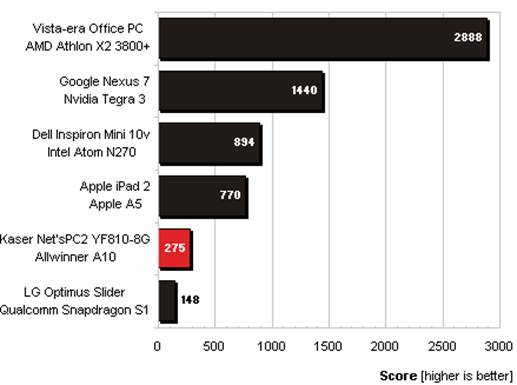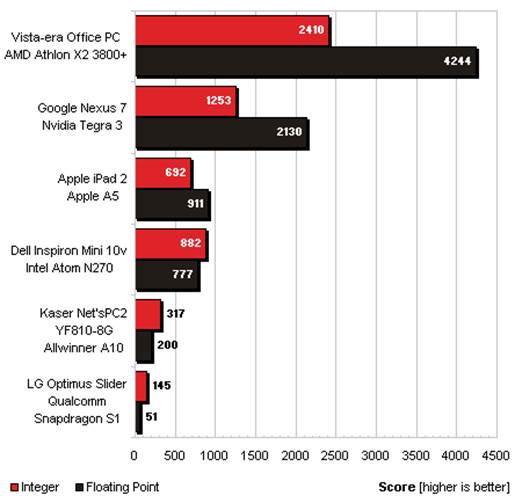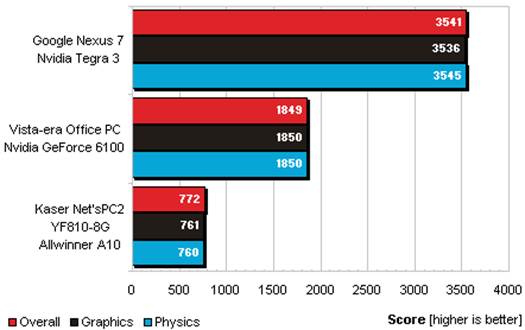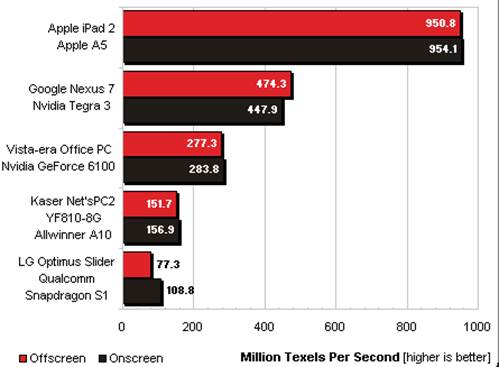System test: Geekbench
Being the only true cross-platform system
test that is available at present, GeekBench offers platform performance data
and CPU.

GeekBench
offers platform performance data and CPU.
Assumed that we’re processing a $100 nettop,
we haven’t expected much. But this Geekbench result actually makes the
performance worth considering. With the only Cortex-A8 1.0GHz core, Allwinner
A10 SoC of Kaser offers less than half the performance of dual-core Cortex-A9 performance
having the same speed in A5 SoC of Apple. Comparing to the first generation netbooks
based on Atom N270, Allwinner A10 offers almost 1/3 the performance. With the
almost 7 times performance of Kaser, Nexus 7 of Google is worth to have the
double price of Net’sPC2. The Vista-based office computer having the same price
offers10 times the performance of the system of $100 Kaser. Meanwhile, Gingerbread-based
LG Optimus S pricing at $50 has its own position, providing more than half the
performance of the $100 nettop based on Android.
5-year-old PC rules the CPU performance, and
Nexus 7 takes the 2nd place. iPad 2 and Dell Mini 10v competes for
the 3rd place, with Atom providing the even higher integer score and
the Apple tablets has the advantages in the motion-point operation. For the
first time, Net’sPC2 passes Optimus S, reaching almost double the integer score
of Optimus S, and almost 4 times in motion-point throughput.

5-year-old
PC rules the CPU performance, and Nexus 7 takes the 2nd place.
While Kaser is humiliatingly beaten by most
of our testing system in CPU performance, the memory expansion is not really
bad. Here, we can see Optimus doesn’t have larger disadvantages than Kaser considering
memory performance, though the very few memory number is a regular problem with
the prepaid smartphones, and we will see a perfect example of this in the
graphics testing session.
Graphics testing: 3DMark and GFXBench
3DMark of Futuremark and GFXBench of
Kishonti (the new name of DXBenchmark and GLBenchmark v2.7) are 2 very
interesting new graphics tests which allows the cross-platform comparisons
between the PC based on x86 and the settings based on ARM. With these tests, finally
we can see the graphics cores inside SoC of smartphone and how the tablet
compares to the old PC.
Unfortunately, Futuremark hasn’t released
the compatible versions of iOS and WinRT of 3DMark, so we have to say goodbye
to iPad 2 in this test. Its’ the same to LG Optimus Slider as its OS is below
the minimum requirement of 3DMark which is Android 3.0. and finally, Intel GMA
950 in Dell Mini 10v stops us from testing that system in the new cross-platform
graphics tests.
On Net’sPC2 YF810-8G, game is locked with 1,280x800
res, which basically is 1,280x672 once you calculate the navigating bar of
Android. We have performed plenty of tests and it seems that this test can’t be
changed. So, if you set up YF810-8G to 1,920x1,080 and play Shadowgun, actually
you’re processing with up-scaled images. The performance doesn’t change
regardless of the res as games are always presented at 1,280x672. So, taking
full advantages of the 27 inch 1,080p screen doesn’t block the graphics
performance of the Nettop.
3DMark

3DMark
We achieves the Smart Buy Award which
passes the beige box. While the office PC has integrated graphics, its
5-year-old GeForce 6100 solution is pretty good, which is capable of playing
games based on the Source machine with high settings at 720p.
This is a shock. While the system tests are
pretty similar to what we expect, with x86 easily beating ARM, it seems that
the ARM-based SoCs are improved a lot in catching up PC when talking about
on-core graphics. Continue the comparison based on price and what many of you
have possessed, $200 Nexus 7 again surprises us.
GFXBench

GFXBench
The low number of useful memory in LG
Optimus S doesn’t allow the scene tests of GFXBench (T-Rex and Egypt) to run
properly. Luckily, the lighter Fill Rate and Triangle Throughput tests run
pretty fine. When not being directly reflected in the game performance, these
tests are perfect to test our basic unusual devices.
These tests run off-screen and onscreen. The
off-screen tests rate the performance regardless of the attached screen,
allowing us to compare the SoCs in many devices with the screen sizes and
different res. Meanwhile, the on-screen tests shows how the devices with
attached screen run in the real world.
The results of the fill rate tests reflect
the result of 3DMark, with 2 devices incapable of taking the 2 bottom position
of the chart. We can see that Optimus S has advantages in real use because of
its very little 320x480 res. However, when running off-screen tests at res that
the built-in screen of Optimus S can’t process, performance lowers by 30%. The
remaining devices have the screens from 720p to 1080p, so the performance
differences between the on-screen and off-screen test are very small.
3 next tests are really interesting as we
can see the performance of all 5 systems lowering when heavier performances are
applied.
In the first triangle test, the platform of
Kaser creates the slightly better off-screen score than the on-screen score.
Once applied vertex lighting, the result of the 2 tests becomes equal. when we
turn to fragment lighting, Kaser creates more triangles each second on-screen than
off-screen.
Notice that the lead of iPad 2 increases
when lots of more complex performances are added in. in 2 first tests, Nexus and
Vista-aged PC follows close behind each other, while the fragment-lit test
finally takes advantages of the newer Nvidia chip of the Google tablet. All 3
comparing systems make Kaser and LG feel ashamed, with the PC of grandparents
reaching 10 times the score of the $100 Android Nettop!